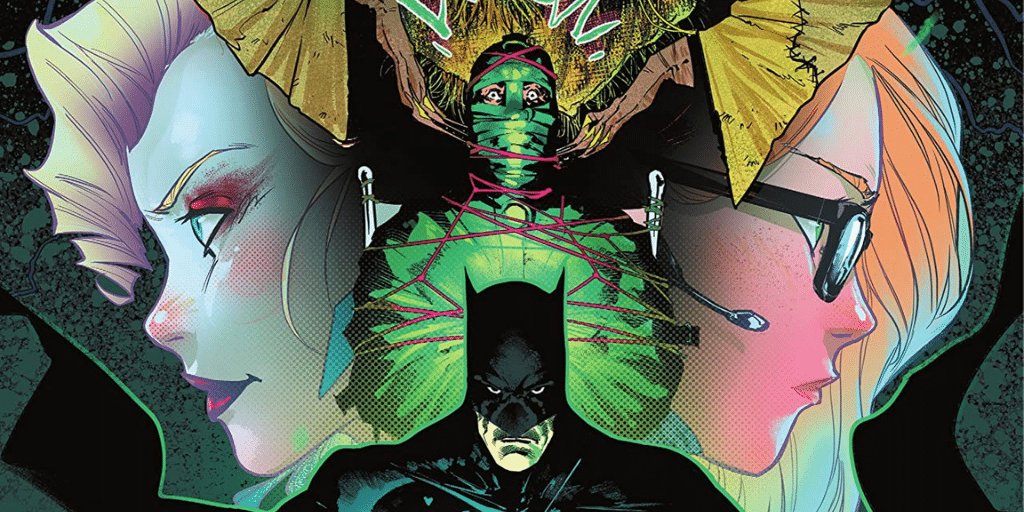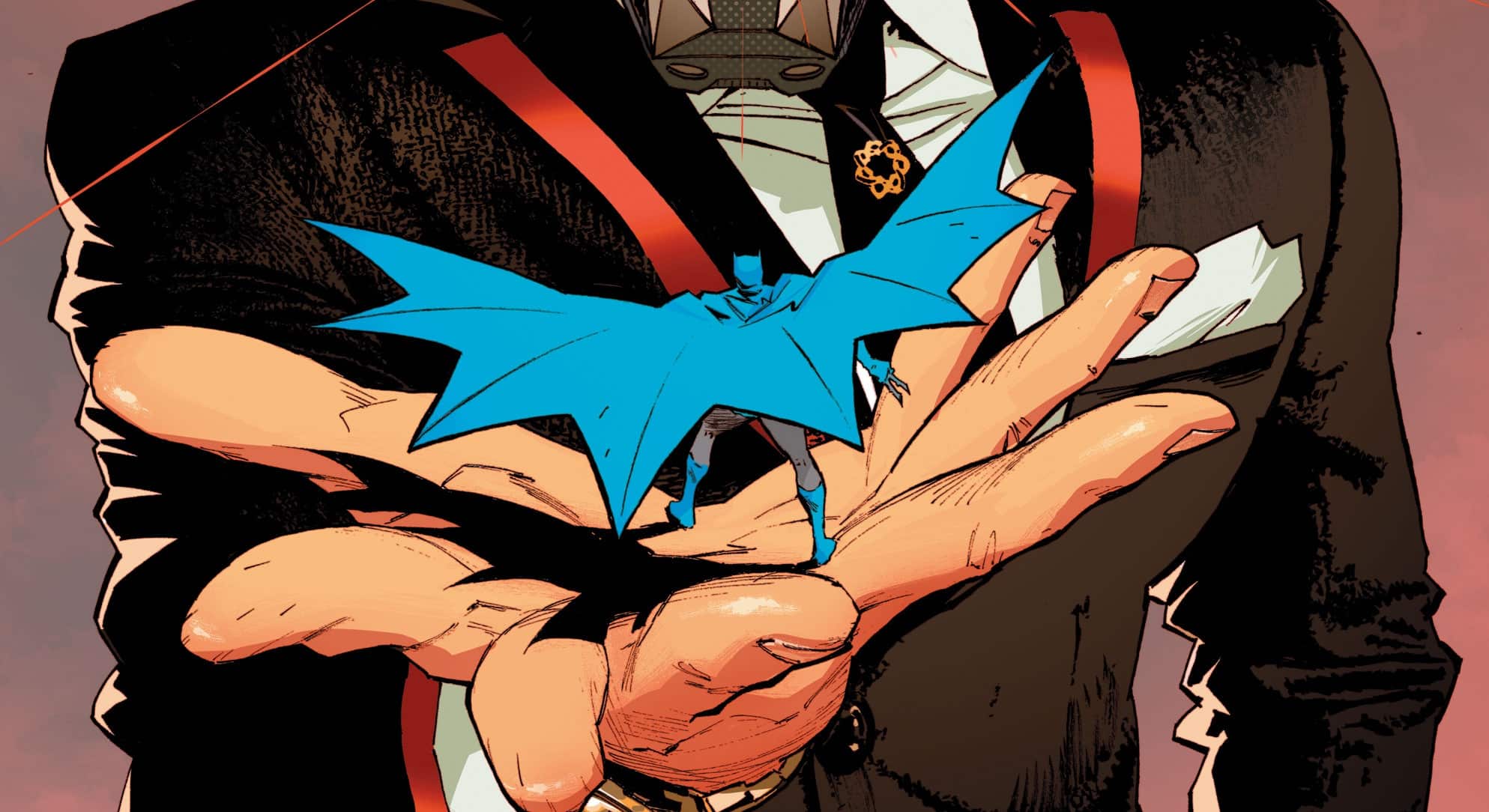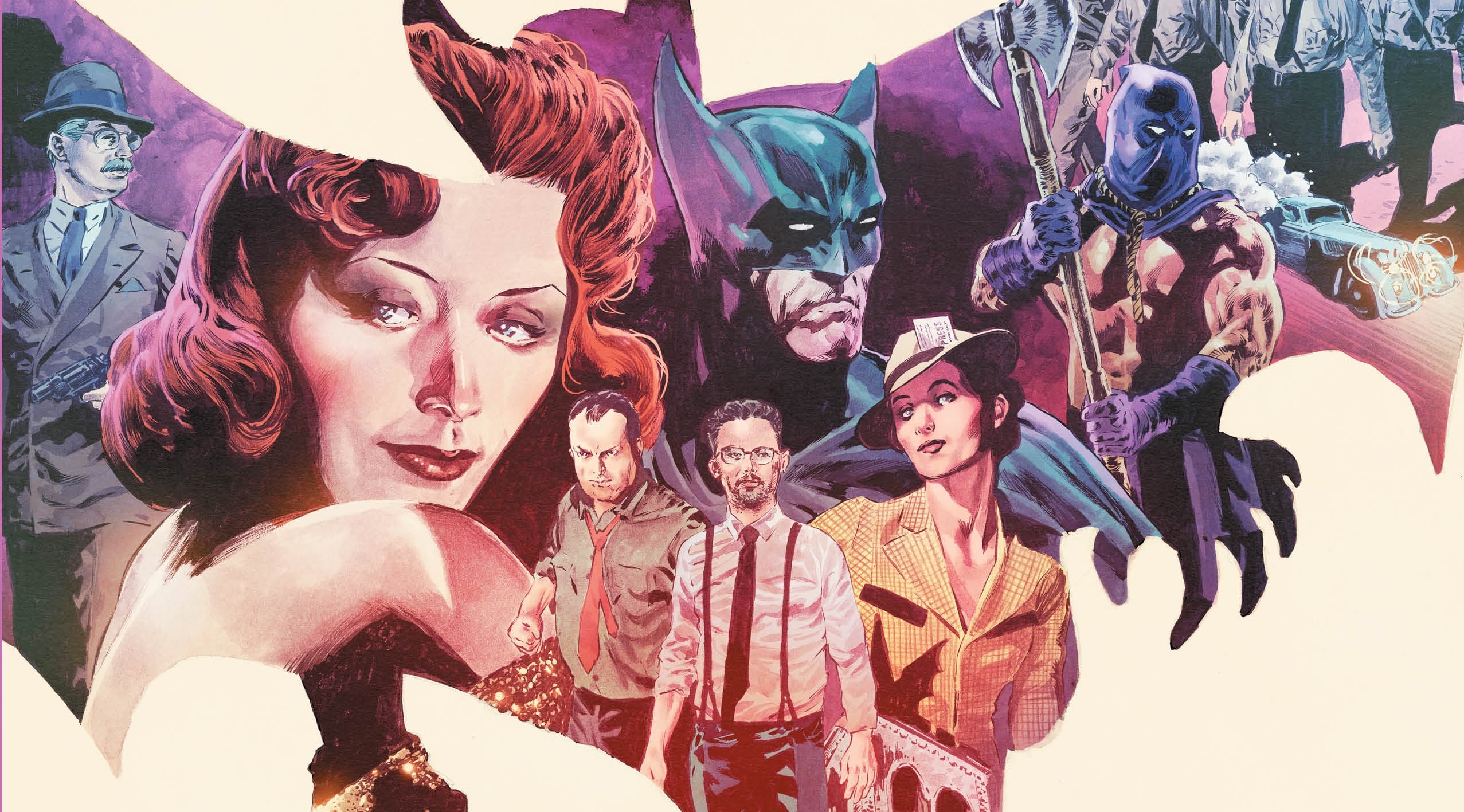Batman investigates the Scarecrow’s latest play and the Unsanity Collective, while Harley tries her best to be her best in Batman #107 with a lead story written by James Tynion IV, drawn by Jorge Jimenez, colored by Tomeu Morey and lettered by Clayton Cowles.
Matt Lazorwitz: I definitely think this issue considers the upward trend that we saw in last issue. It’s still a bit busy, with a lot of threads that aren’t (at this moment) directly affecting the title character, but it’s a lot less messy than the arc right before the two-month hiatus.
Will Nevin: That arc that introduced He Who Shall Not Be Mentioned? Yeah, that was a bit rough. This arc, though, seems to be better at the moment — but I’d still take Detective Comics in a horse race.
Fear is a Four Letter Word

ML: I was recently doing some research, and I realized there aren’t a ton of really major Scarecrow stories. For a villain who exists in the lower tier one or very top of tier two of Batman villains, he is rarely the central focus of a story; he’s usually teaming up with another villain rather than being the big bad.
WN: Scarecrow isn’t that complex of a baddie, is he? Physically, Crane is unintimidating. After that, he’s got the gas/fear toxin as a threat, but Batman can neutralize that with *waves hands at antidote.* So it doesn’t surprise me that he’s used most often as a supporting heel, which is really what he is here — although maybe Batman doesn’t see the whole plot like the readers do at this point. The unique turn in this story — something I think is pretty neat — is that Scarecrow is attempting to manipulate the public and the mayor with good, ol’ fashioned, not-from-a-gas-canister fear so as to achieve some political goal for his Secretly Bad Tech Bro friend — making him an honest-to-goodness terrorist.
ML: Yes! That twist, the fact that Scarecrow is leaning into the fact that he’s a psychologist, which is what he has a doctorate in, as opposed to a chemist, which is sort of a sideline for him as far as his backstory goes, is fascinating and a great twist on the character. There’s only so many times he can come up with a new variation on fear gas. This is expanding his repertoire, which is important when you’ve been playing the same game since the Golden Age, and Jorge Jimenez’s decidedly creepy design helps a lot. We discussed it last time, but giving him that weird, otherworldly shape and the gas mask really adds to the creep factor. Batman: The Animated Series and the Arkham games realized you needed to add something to the Scarecrow design to make him truly scary, rather than a guy in ratty clothes with a bag over his head, and I like that we’re leaning into something in between that Arkham design and Tim Sale’s version, which was the previous comics gold standard for Scarecrow.
WN: Ahhh, those nightmare sequences. Takes me back, Matt. Scarecrow — as a property, as an institution — seems to be in great shape here, and while we’re going to get into how Tynion is using some of his new characters in a bit, I wanted to talk about one moment associated with the Scarecrow investigation: Renee Montoya does not come off as interesting or anything more than a stock character in her confrontation with Bats. Maybe I’m asking for too much from a single scene, but that was thin as hell in terms of her character.
ML: Yes, especially for a character who has such a history with Batman and who is herself a mask, even if she’s not in that identity right now. I want more from Renee; she’s usually one of the more pro-Batman cops on the force, so you’d think she would be pulling some post-Year One era interference for Bats. I would have no problem with Renee having a change of heart on masks, but I’d need a reason for it, and frankly we haven’t had enough time here to get that reason. The last time she showed up, in Greg Rucka’s excellent Lois Lane miniseries, she was full on Question, and suddenly she’s back to being a cop? Could we maybe have spent some more time exploring her, a character we’re already invested in, as opposed to introducing more paper-thin characters? And on that note…
We’re All a Little Unsane Here

WN: Got a quiz for ya, good buddy: How many characters or concepts or organizations (or whatever else you can think of there) did Tom King add to the canon during his run? I’ve got two in mind.
ML: Well, one is Gotham Girl/Gotham for sure. The reintroduction of Thomas Wayne of Flashpoint into the main DCU is another. Is there another you’re thinking of?
WN: I was counting the Gothams as two separate characters, so looks like you win. (Bonus points for Thomas.) My point here is that King didn’t do a lot of new stuff, and I don’t think we faulted him for it. Tynion, however, seems like he’s doing nothing but adding new characters, and I’m going to keep complaining about it as long as people seem to brush it off. It’s exhausting because the more he piles on — the more he dilutes, the more he fails to build the groundwork for the things he introduces — the more tiresome this run becomes. The Unsanity Collective and Mister (Master?) Wyze are two more things I didn’t need in this book. And, sure, they might be neat and novel, and he may be going somewhere interesting, but, Matt, I’m so tired.
ML: You’re absolutely right, and the issue is the pace. If you want to introduce a lot of new concepts to try to find your Bane (the ’90s big new character in the Bat mythos), Damian (the ’00s) or the Court of Owls (the ’10s), I understand it. But introducing a new character an issue seems like overkill.
And if Tynion was someone who wasn’t familiar with the Bat mythos overall, I might be able to excuse it. There are plenty of superhero runs that introduce a lot of new characters with a writer who admits to not knowing the character’s continuity. But the last page of this issue absolutely shows that Tynion knows Batman!
WN: Looks like I might know enough of the continuity here — what did you read into that last page?
ML: Granted he just says “Match” not “Matches,” but Batman’s recurring underworld undercover identity, used consistently from the ’70s through at least the ’00s, was “Matches” Malone, a small-time arsonist and thug who looked just enough like Batman that with some makeup and a fake bushy ‘stache, Batman would often go undercover as Matches. We saw less of Matches as Batman spent less time detecting, but there are plenty of stories where Matches shows up, and here it looks like Tynion is bringing him back, which shows he clearly knows a lot of this old school Bat lore.
WN: Well, shit, now I want to fire up the ol’ DC Universe Infinite app and read some “definitely not a narc with that mustache” Matches Malone stories. But that reference speaks to exactly the point you’re making: Matches means something because he was given time to develop and used by multiple writers over the decades. He can be reinterpreted, recontextualized, re-whatever’d. He’s durable. All of Tynion’s stuff seems made for one specific reason for a particular moment (which is as much an indictment of his naming scheme as anything else). Discardable. Fleeting.
ML: And that’s a shame, because the idea of the Unsanity Collective does seem novel, but it’s getting lost among all the sturm and drang. Hell, since their schtick seems to be about moving past trauma, there is a connection/contrast to Scarecrow there, as what is fear other than wallowing in previous traumas in a lot of ways? But the fact that a connection like that only occurred to me now, when I’m sitting and doing a deep analysis of the book, as opposed to it feeling organic, says that it’s too little.
WN: Maybe in #108 we can slow the heck down and give this thought some time to breathe … but I have my doubts.
Harley and the Fuzz
ML: So, as we are writing this on April 8, 2021, with the 24-hour news cycle deeply following the trial of former Minneapolis police officer Derek Chauvin, the Harley pages in this book take on a different light than I think they would have a year and a half to two years ago, I think. Is Tynion actively trying to make a point about Gotham policing here? Or is it more some Harley action and I’m seeing something just because I’m a news junkie?
WN: No, I think you’re right here — this is definitely commentary on policing and incarceration. Harley has been on both sides (whether that’s doctor/mentally disturbed or criminal/trying-to-do-better, I think either works), and she sees “Stabbo” as someone who only needs medication and, more generally, help. But more importantly — and this gets to the broader point — she sees him as a human being worthy of respect.
ML: Something the police officer clearly does not. He actively says he doesn’t care what Stabbo needs. Batman is a comic where these particular lines get blurry, and it’s easy to tell a Batman story from the perspective of the “villain” and have Batman clearly be the bad guy: rich guy beating up the lower class and mentally ill. I personally find that a bad faith argument, since you’re attempting to force real world mores on a fantastic world where there are aliens, demons and super criminals running around, but policing in Gotham is a bit more cut and dry, especially since Stabbo isn’t the Joker or Two-Face, but just a person with a mental problem that there is an active remedy for. I think a deep discussion of these issues needs more time and more story pages than this issue has, but the fact that Tynion is willing to at least start the conversation is something worth noting.
Bat-miscellany
- The only — and I mean *only* — way Ghost-Maker makes sense is as some parody or otherwise comedic figure. He’s insufferable, the costume is goofy and I want no part of whatever story Tynion wants to tell with him. Move. On.
- The lettering in the Ghost-Maker backup was offensively bad.







